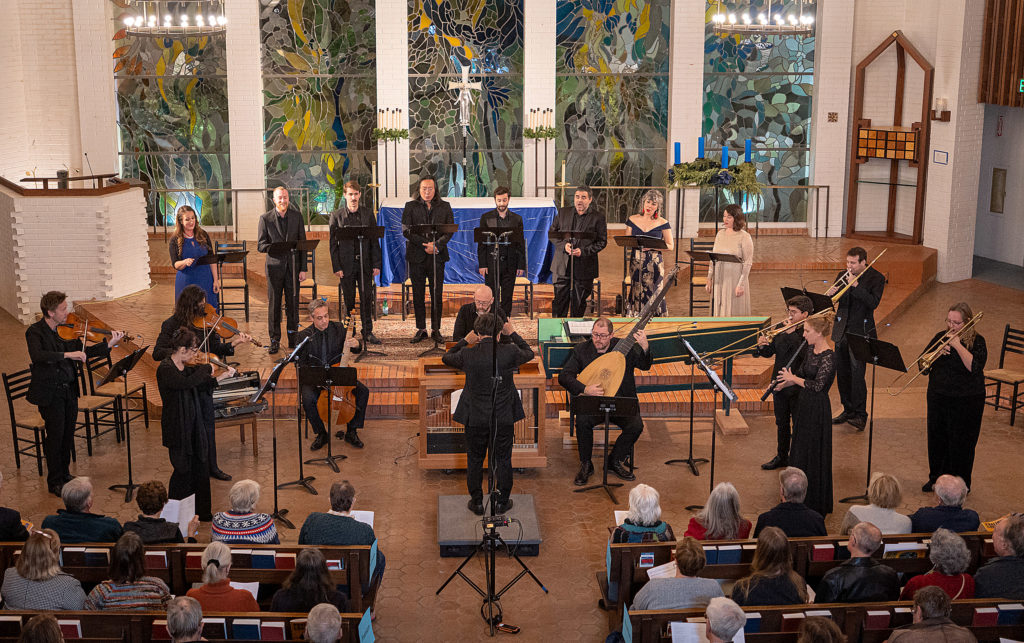Bach Collegium San Diego Celebrates a German Baroque Christmas
The best early music ensembles perform music from centuries before the common practice period in an historically informed manner that gives the contemporary listener a credible account of how that music sounded. In Saturday’s Bach Collegium San Diego concert Praetorius Christmas, Artistic Director Ruben Valenzuela took this one step further, providing a convincing historical context in which the music would have been used.

Bach Collegium San Diego; Ruben Valenzuela on podium; Tesserae Baroque at for right [photo (c.) Gary Payne Photography]
Most striking on the program were Praetorius’ robust chorale concertatos: “Puer Natus in Bethlehem,” (“A Babe Is Born in Bethlehem”), “Wie schön leuchtet der Morgenstern” (“How Brightly Shines the Morning Star”), and “Es ist ein Rössentsprungen” (“Lo, How a Rose E’re Blooming”), with their bold choral declamations regularly supported by the warm sonority of the string ensemble and reinforced with brass quartet in the bright finales. In his day, Praetorius was avant garde, composing the in Monteverdi’s flashy new chordal Italian style with its clever echo effects and spiffy dynamic contrasts—none of that pious, high Renaissance polyphony for Praetorius! And while these chorale concertatos are rewarding on their own terms, it is also clear to today’s listeners that Praetorius’ chorale concertato is the musical form that a century later became the choral cantata of which J. S. Bach wrote hundreds in his vocation as a Lutheran Church musician.
For this concert, the Bach Collegium used but eight strong singers and seven instrumentalists (strings and continuo players), augmented by a quartet of cornetto and sackbut players from the ensemble Tesserae Baroque. Solo vocalists sang some chorale stanzas, and the breadth of their vocal colors and approaches gave welcome variety to the program. But singing together they formed a most pleasing, cohesive ensemble. The polished brass players of Tesserae added welcome panache to the larger ensemble pieces. Kudos to theorbo player John Lent, whose vibrant technique gave welcome drive to the continuo part.
In addition to his fleet conducting, Ruben Valenzuela sprinted over to the All Souls’ Fritts-Richards organ several times to play some of the program’s solo organ works: a sturdy prelude from the 1650 Lüneburg Tabulatur on “Vom Himmel Hoch” (“From Heaven Above”), Martin Luther’s own Christmas hymn; Samuel Scheidt’s delicate prelude on “Wie schön leuchtet der Morgenstern,” and Heinrich Scheidemann’s free Organ Praelambulum, WV 39. The colors of the All Souls’ North German Baroque organ certainly suited the style of these organ pieces, as did Valenzuela’s spirited interpretations.
This concert filled the All Souls’ sanctuary, a tribute to the Bach Collegium’s loyal following that expects a plentiful reward even when the program is filled with rarely heard composers. And Valenzuela had a role for his audience: the grand finale was a performance by all of the performers and the audience singing the German carol “In dulci jubilo,” handily included (words and melody ) in the program. Originally the text was a combination of Latin and German, but we sang a good translation in Latin and English. It proved a most satisfying conclusion to this nonpareil visit to a Lutheran congregation in 17th-century Germany.
This concert was given twice: on December 9, 2022, at Sts. Constantine and Helen Greek Orthodox Church in Cardiff and on December 10, 2022, at All Souls’ Episcopal Church in San Diego’s Point Loma community. The December 10 program was attended for this review.

Ken Herman, a classically trained pianist and organist, has covered music for the San Diego Union, the Los Angeles Times’ San Diego Edition, and for sandiego.com. He has won numerous awards, including first place for Live Performance and Opera Reviews in the 2017, the 2018, and the 2019 Excellence in Journalism Awards competition held by the San Diego Press Club. A Chicago native, he came to San Diego to pursue a graduate degree and stayed.Read more…
